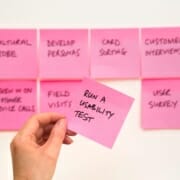Strategies For Effective Project Management In Mobile App Development
Project management is fundamental to the successful completion of any mobile app. But it’s a deeply involved process that requires careful planning, plenty of meetings with stakeholders, and constant collaboration. While there are several ways to approach project management, we’ve prepared this handy guide to help you focus on the most effective strategies.
Why Project Management Is Crucial For Your Mobile App Projects?
Developing mobile apps consists of a series of laborious and complex tasks. To uninitiated developers, the opposite may seem true, considering the vast quantity of apps that hit the app stores daily. Yet, few of these apps make a dent in the marketplace due to a lack of project management planning.
Successful mobile apps are seldom created on impulse or by solo hobbyists and freelance developers. Instead, they’re the products of visionary appreneurs who partner with talented app development studios like NS804. Quite often, other stakeholders like app publishers, businesses, and marketing teams will also contribute. Keeping all these entities on the same page is excruciatingly challenging — but necessary for the success of any app project.
That’s where project management planning comes in. It helps all stakeholders involved in your project understand its core concept, how much it will cost, and how long it will take until completion. Furthermore, the plan will detail all goals, expectations, resources, tools, and methodologies necessary for the project.
Depending on the scope and needs of your project, the plan may include additional details. In all cases, it’s best to hash out a project management plan that is as detailed as possible. It’s also wise to detail a contingency plan or offer alternative solutions for project bottlenecks or missed milestones. Ultimately, the primary goals of project management are to deliver a completed project and reduce the risks associated with app development.
USE OUR APP COST CALCULATOR TO ESTIMATE THE COST TO BUILD YOUR APP!
What Does Project Management Entail?
Project management includes all the details and specifications required to complete an app project. A common misunderstanding involves the ideation process of app development. Some team leaders will integrate this process into their planning, while others leave it out. So, which method is the correct one? Usually, it’s best to leave out the ideation process since this happens long before a development team will tackle the project.
A good example is the appreneur who comes up with an app idea and commences with basic ideation on a handkerchief or piece of paper. Then, the appreneur approaches a development studio to discuss this idea, gain additional insight, and for further brainstorming.
The studio will offer guidance and create a wireframe to flesh out the appreneur’s ideas. At this point, the appreneur and the studio’s development team have a basic understanding of what the app will look like. If necessary, the appreneur will greenlight the creation of a prototype for a better replication of the finished product.
Once the appreneur is satisfied with the wireframe or prototype, it’s time to approve or abandon the project. If the appreneur decides to forge ahead, project management planning will take center stage. During this stage, the appreneur, the project lead, the designers, the development team, the marketing team, and any other stakeholders will commence a series of meetings.
Ideally, most initial meetings will occur face-to-face at the development studio’s physical premises. NS804 makes this easy as we have offices in Richmond, VA, Charlotte, NC, and Denver, CO. But we also make it easy for clients to stay in the loop via our Slack channels and to peruse the project management plan via Trello.
Is Project Management Necessary For Mobile Game Development?
It’s essential to conduct project management planning before you start making your mobile game. Developing modern mobile games is hard, so it’s foolhardy to tackle such projects without a carefully conceived plan from day one. You must also prepare a game design document (GDD) that will contain the following:
- A summary of your mobile game: This section includes details of the core concept, genre, target audience, and overall scope of your game.
- Gameplay details: In this section, you will describe all the objectives and challenges players will face.
- Core game mechanics: Describe all the physics, rules, and player interactions within your core game loop.
- Worldbuilding: This section will include information about your game’s characters, story elements, levels, and locales.
- Game assets: Describe the types of graphics, music, and sound effects that you will include in your game.
- Game development tooling: Include details about the game engine, graphic design software, and 3D modeling tools you will use during development.
Set Realistic Milestones For All Stakeholders
One of the first and most essential steps of your project management plan is to set milestones. Ensure that all these milestones are realistic and that all stakeholders are on board. Conducting face-to-face meetings early on is a great way to confirm which tasks each stakeholder will handle during the development of your app. At times, it won’t be possible for everyone to meet physically, so you will have to rely on video conferencing.
Verify that all stakeholders understand every phase of your plan and the timeframe of each milestone. You may use Trello, to-do lists, or spreadsheets to keep everyone on the same page. Regularly check to see that all stakeholders are meeting milestones, and message or email those that fall behind. If any team member isn’t meeting their obligations, remove them from the team and replace them with someone who will fulfill your plan.
Carefully Plan The Resources For Your Project
How you manage your resources will make or break your project. But what constitutes these resources, to begin with? These resources may include key team members, specific skills, hardware, software, and tooling. Additionally, include any cloud services, testing, and app deployment services you will use for your project.
But be sure to assess only the resources you will use for this specific project and not for other projects you’re working on in tandem. You want to be as accurate and detailed as possible when you assess all the resources you will include in your plan. And that’s crucial because it will impact your project’s cost analysis. Many stakeholders, particularly investors, will eventually want a cost breakdown.
Furthermore, conduct several meetings with the most experienced members of your team to pinpoint the most suitable resources for your project. Don’t assume that certain staff members or tools that proved effective in a previous project will also serve your upcoming project. Instead, be willing to switch things up based on deep and detailed analysis of similar projects, current development trends, and the current state of the app marketplace.
Consult Your Team Lead To Set The Timeline
Ideally, you should have a team lead — but if you don’t — you must assume this role instead. But leading an app development project is challenging, so we recommend you work with a competent studio if you can fit this into your budget.
Whether you decide to work with a team lead, hire a studio, or go solo, you must set a timeline. That’s because you don’t want your project to consume all your time and eventually burn through all your funding.
But if you haven’t developed apps before, you may find it hard to determine an accurate timeline. More often than not, you’ll probably be way off in your timeline if you don’t consult a professional. Sure, you may watch several YouTube videos and read blog posts about app development, but nothing beats working with someone with hands-on experience.
Your timeline must align with all your set milestones and be realistic and trackable. Also, consider all scenarios that will cause delays, such as staff members taking sick leave, holidays, internet outages, funding issues, API updates, backend integrations, troubleshooting, etc.
Above all, hold all stakeholders accountable for meeting milestones on time. Stick to a weekly or bi-weekly routine to check everyone is committed to your project management plan.
Detail Usage Of All Communication Channels
Even the most rock-solid project management plan will fail without properly implemented communication channels. That’s because all stakeholders must communicate regularly during each stage of the development process. Any communication bottlenecks will delay or derail your app’s progress and even lead to a catastrophic outcome.
To avoid all this, you must set up all the communication and feedback channels you’ll use during development and outline these in your plan. The good news is that there are many excellent paid and free communications services available, as follows:
- Chanty
- ChatWork
- Discord
- Google Chat
- Messenger
- Microsoft Teams
- NuovoTeam PTT
- Trello
- Troop Messenger
- Slack
- WhatsApp Business
- Wrike
Some of these services also have integrated project management features. Take the time to assess the most suitable communications services for your app project. You may want to opt for an all-in-one solution to simplify your workflow. Alternatively, you may need more advanced or specific features, so you may need to rely on several disparate services.
Set And Follow Guidelines
Project management relies heavily on team members following specific guidelines. You must decide on these early on and cover them in detail in your plan. These guidelines will cover multiple issues, like how your team will handle communications, app testing, and quality assurance (QA).
Draw up guidelines that will facilitate a smooth app development process but also deliver a quality product. And ensure that you post these guidelines in all the places where team members will see them. Consider posting communications guidelines and etiquette rules in all your communications channels.
Due to the complexity involved with testing, bug tracking, and app deployment, prepare documentation that covers all these aspects in detail. If there’s significant information that you need to cover, then consider creating several eBooks or PDFs. These will include guidelines and best practices that the relevant team members must follow. Most communications tools allow you to upload and distribute these files to reach the right people.
You may decide to automate your testing process, especially if your team’s headcount is low. But this doesn’t mean you shouldn’t set guidelines for such a use case. That’s because setting up automated tests is an involved process that requires troubleshooting. Once set up correctly, automated tests will run flawlessly and scale to meet project scope.
SCHEDULE A CONSULTATION WITH AN APP DEVELOPMENT EXPERT TO GET A CUSTOMIZED QUOTE!
Choose A Project Management Methodology For Your App
Eventually, you’ll decide on a project management methodology that best suits the developments of your app. There are five commonly used methodologies, so you must pick one listed below:
Agile
Agile project management is one of the most common methodologies used by developers. It’s popular due to its flexibility since project tasks consist of shorter phases. Thus, teams focus on completing projects on time and within budget while allowing for bug fixes and changes at every stage of development.
Scrum
Scrum follows Agile’s principles with an emphasis on short team meetings held daily. There’s also a greater emphasis on assigning tasks to specific team members and completing tasks in order. Therefore, it’s a good choice for teams that require clearly defined roles and responsibilities.
Extreme Programming (XP)
XP is yet another methodology firmly within the Agile camp. It’s aimed at experienced software developers who value simplicity and good communication pipelines. Do keep in mind that XP is unsuitable for new developers or teams that struggle with transparency.
Kanban
Kanban relies on to-do lists, columns, and cards to visually present project tasks and completion. Popular platforms like Trello are based entirely on Kanban, so it’s easy to onboard and expose team members to this methodology. Kanban is a good choice for teams that must roll out bug fixes, patches, and updates regularly.
Waterfall
Waterfall project management is the simplest but also the most inflexible method here. Teams complete tasks according to a pre-defined and ordered sequence that flows downwards, hence its name. Therefore, it’s only suitable for teams that will follow a rigid plan with no possibility of implementing changes at a later stage.
In Conclusion
App development is often challenging, complex, and risky. But you can reduce all these factors significantly by implementing the right project management strategies for your app project. Contact NS804 today to learn how we’ll help you complete your app on time and budget!











 https://unsplash.com/photos/bMTl6uFMONg
https://unsplash.com/photos/bMTl6uFMONg https://unsplash.com/photos/3iTRMP8Uq2k
https://unsplash.com/photos/3iTRMP8Uq2k
Leave a Reply
Want to join the discussion?Feel free to contribute!